Chat 14
Quiz Answer:- In this picture of a Paris workshop you can see the left arm of the Statue of Liberty in the background. Correct answers fromMick Dughan, Kath and Don Sales, Ann and Pat Davy, Don Eades, Mick Leach, Ken Palmer. It is often stated that the statue was a gift from the French people. True or not, read an alternative story here.
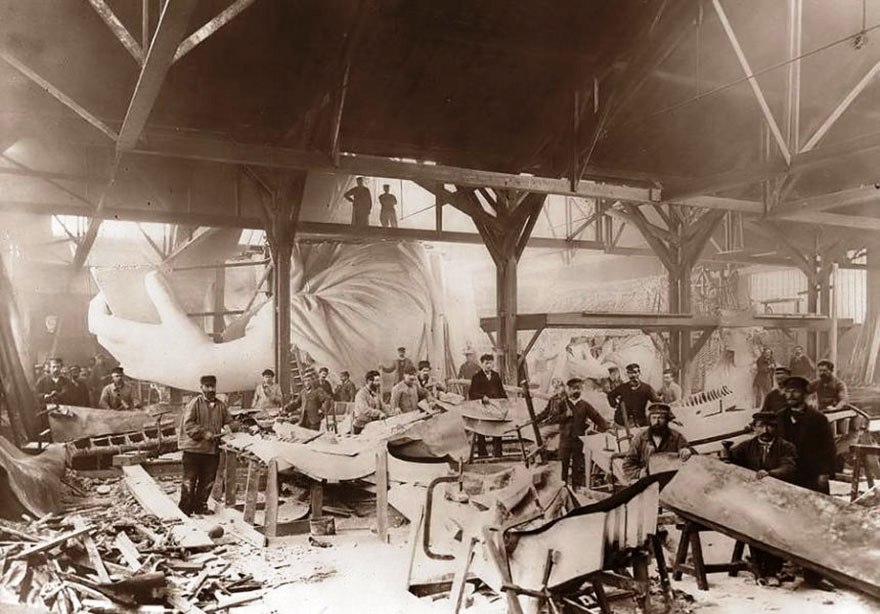
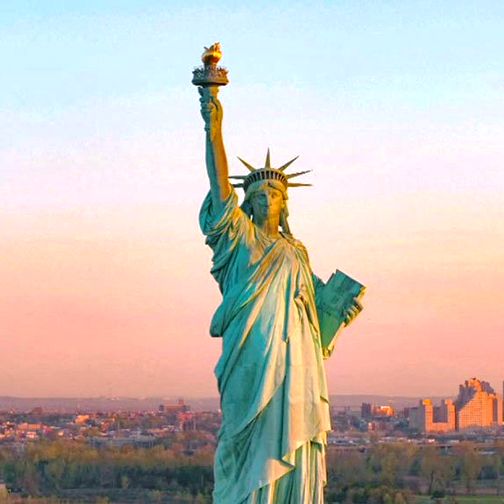
Here is a photograph of an extremely well known member of the Burton Section VMCC with his first race bike. An easy guess what the bike is but who is it?
Answers by email to edgrew@virginmedia.com
P.S. He will write a bit about it when he has time.
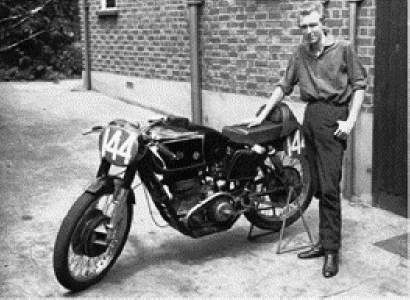
A nice little piece from Trevor Shakespeare:-
Hi there Eddy, seeing Tony Harris' note about the
CB92 reminded me. When I was 16 and wanted a bike. I found a CB92
for sale in the 'sold as seen' section at Hartills in Bilston
for £25.00. My dad borrowed a van and we collected it. It was a
1961 model, It was not in very good condition, BUT it had a tachometer and
Avon racing tyres. The number was 927TFM and the first name in
the RF60 log book was Stuart Graham, who, at the time I bought
the bike, was a works Honda rider. I has the bike for about 18 months, sold it locally and it has disappeared. I have tried to
track it down, but no chance. Many years later I met Stuart Graham when he was a guest at VMCC Mallory. He remembered
the bike, a very nice guy.
P.S.
The Luck of the Irish or was it Irish luck?
The AJS and Matchless Owners Club organise several rallies a year, and one of these is the International Rally. Members have travelled far and wide to attend these rallies in places like Norway, Portugal, Italy and even New Zealand.
A few years ago a group of members who live in the Republic of Ireland were persuaded to organiseethe rally in the heart of their country. The site chosen was in a village called Street. The nearest large town was Mullingar that is situated in Ireland’s ‘Lake district’.the rally in the heart of their country. The site chosen was in a village called Street. The nearest large town was Mullingar that is situated in Ireland’s ‘Lake district’.
The International Rally is usually held over a long weekend late May or early June, and Julie and I decided to take our motorhome over for an extended stay that would include a visit to the rally. We would spend around 10 days touring around the southern end of the island and then go to the rally. We would strap our Matchless G15 twin onto the motorcycle carrier at the rear.
The Emerald Isle is indeed a green and pleasant land because it rains a lot, and with this in mind we packed lots of spare waterproofs to allow one set to be drying out as we ventured out on the Matchless to sightsee.
We had a few days in the Wicklow Mountains and then headed further south. We don’t like tourist traps, but the Killarney National Park and the Dingle peninsula in the south west corner was a must visit. We found a campsite near the centre of Killarney town and used this as a base to explore the region. An early weekday start gave us a pretty clear run around the Dingle peninsular. This peripheral road offers great views and the ride is enjoyable if you can avoid the many tour coaches that always appear full of Americans. I would imagine that many of them were over ‘the pond’ to try and trace their ancestor’s footsteps.
The weather so
far had been brilliant, but you know the saying “Pride before a
fall”, and it started to rain heavily one morning as we ventured
out to explore some new vistas. However, it only lasted about an
hour and the rest of the day was in sunshine. Will our weather
luck hold out?
It was a Sunday and with the prospect of tourists in abundance
we decided to head further inland to be in the “middle of
nowhere”. I plotted a route using as many small roads as
possible and headed for the hills.
In the middle of nowhere
We were having a great ride and climbing a descent hill when “clank” and we had no drive to the rear wheel. The chain was broken, but a quick inspection revealed that it wasn’t the split link that had gone. This was a little worrying, as although I usually carry a spare split link and a few tools this looked a bit more serious. Sure enough, we had broken down “in the middle of nowhere” and we didn’t have a signal on the mobile phone.
We could just see
a bungalow at the end of a longish driveway, but his was the
only habitation for miles. Just as we were about to walk up
towards the bungalow we were met by a car. The gentleman
enquired in a lovely Irish accent if we needed help. “We would
be very grateful” was our response. “It’s Sunday today. I’m just
popping out to get a newspaper. If you can, push your bike up
the drive and park outside the garage door. I’ll be back soon”.
The weather was warm and sunny again, so heaving the bike up the
hill we got a sweat on. The man returned and told us that he
repaired cars as a sideline and we could use his tools if that
would be a help. He opened the garage doors to reveal a fully
equipped workshop. “Help yourselves to any of the tools”. Was
this a dream?
|
|
|
|
|
Doors open revealing lots of tools |
Working on the bike |
We set about
repairing the chain. My theory on the snapped chain was a stone
had flipped up and damaged the chain as it went round a
sprocket. A side plate was broken, but also two rollers were
split open. Again I checked the split link and it was perfect.
My only option was to shorten the chain by a link and rejoin
with my spare split link.
|
|
|
|
| Angle grinder was useful | Hammers are great |
To get the necessary slack I removed
the adjusting screws from the swinging arm and pushed the wheel
spindle right up to the ends of the fork slots. There was just
enough slack!
The Irishman appeared with his wife and four children half way
through my endeavours to fix the problem using an angle grinder
etc. “As I said, it is Sunday and I am taking the family to
Mass. The Swarfega and towel are next to the sink. Please close
the doors before you leave. Have a nice day”. He and his family
disappeared down the road leaving Julie and myself in charge of
several thousand euros worth of kit; what a nice man! The
Swarfega worked well and so had the tools because the bike ran
as sweet as a nut the rest of the day. When we arrived back in
England I put 10 euros in an envelope and hoped that he would
enjoy a Guinness on us.
We left Killarney and had a midway stop for a couple of nights in Askeaton, a nice historical town in County Limerick on the banks of the river Deel. If you telephoned ahead you could camp for free in the swimming pool car park and also use the facilities with no charge. We woke the next morning after a great nights sleep, but as we looked out of the motorhome window we could see lots of horses tethered on every bit of surrounding grass. We mentioned this to the swimming pool manager and he said that they belonged to ‘the travellers’. “They are nuisance and quite often they will come and tether a horse in the middle of your pristine front lawn”. We didn’t have any bother and really enjoyed the town.
One piece of local history was that the town hosted a local ‘Hellfire Club’. The club was one of many in both England and Ireland where rich young rakes indulged in ceremonial drinking, dining, gambling and carousing. A few clubs crossed the line into sex, blasphemy and sheer bloody badness - or so the rumour goes. Our local AJS/Matchless Club section visited one in West Wycombe a few years ago on a Posh Weekend – no we didn’t join in (unfortunately).
Off we set to join the rally a little further north. The weather was still perfect and actually it was a little too hot for many. We had the usual run out in a ‘snake’ of bikes. All the locals were out because the press had published articles in advance of the do. Everyone waved, from tots to grand parents, as circa 200 bikes of the marque wound their way along the country lanes in brilliant sunshine.
Hellfire Club West Wycombe
|
|
|
|
| Packed into the village square | Irish band |
The rally was a success despite some problems of under estimating the number of participants and the needs of so many campers in a small village set up, but that is another story about “showers without water” and the infamous “ting”, that I might tell you about some time……. and by the way we only had that one hour of rain in 17 days. Who says it rains in Ireland? John Grew
Matchless G11 600cc Twin - Lucas E3L Dynamo 12v Conversion -
Part 2
As per John
Earp’s comment, I apologise for the lengthy script but, as he
found, describing even basic technical stuff results in a fair
bit of detail. It is
easier to send off components to specialists but for some not so
rewarding with that sense of achievement when complete.
I hope this write up encourages others
to have a go themselves, especially when the replacement parts
are available.
Four days after placing the order the
replacement parts arrived by courier.
After checking the
contents against my order and with all correct I could start to
dismantle the dynamo, but only after taking a couple of
photographs showing the wiring connections.
Upon removal of the two long fasteners,
the armature, still with the drive end attached and complete,
could be withdrawn from the dynamo body.
With the armature
gripped in the vice I started to undo the pinion gear bolt. This
bolt is fitted with a tab washer but the locking mechanism was
not present. The head of
the bolt is in a recess so either a ring, box spanner or a
socket is needed. I found the bolt to be very tight and both my
12 point ring spanner and socket did not have sufficient
purchase.
Fortunately I have another metric socket set with hexagon
sockets and, much to my relief,
the 15mm socket was a snug fit on the bolt head with a
light tap from a copper mallet.
Although tight all the way out the fastener came undone,
the bolt had been installed with a coating of Loctite.
Next task was to extract the pinion gear
which is a press fit onto the parallel shaft with the drive
provided by two woodruff keys. Easier
said than done, as there is minimal clearance behind the pinion
therefore no room to use the small extractor I had bought
especially for this job. Behind
the pinion bearing is a hardened steel spacer where the lip seal
bears. The seal housing
bore is smaller than the pinion OD.
Nothing can be removed
from the drive end until the pinion is extracted.
With caution out came a couple of small
screwdrivers to gently apply leverage to the pinion, I could not
risk damaging the mechanical seal housing.
The pinion, as expected,
was very tight. Recalling the retaining bolt was coated with
Loctite it was a safe assumption the pinion was also assembled
with Loctite. Out came
the blow lamp to gently apply heat to the pinion without
overheating the pinion teeth nor burning the mechanical seal as
the replacement was still in the post.
At last some slight
movement was felt. Now encouraged slightly larger screwdrivers
were used until there was a sufficient gap to make use of the
extractors. With the
pinion successfully removed the spacer and the seal housing was
easily removed.
Now to remove the drive end bearing
which has to be extracted, before the bearing housing can be
removed. The
housing would push back but not far enough to allow the bearing
extractor legs to engage behind the bearing.
With the armature
between the slackened jaws of the vice and the bearing housing
pulled up against the vice the end of the armature was lightly
struck with the copper mallet, the bearing shifted on the shaft
sufficiently for the extractors to be used.
At the commutator end of the armature I
only required to remove the screw at the end of the shaft.
Now I had removed all
the re-useable parts from the unserviceable 6 volt armature.
Next task, which I was a bit apprehensive about, was to remove the 6 volt field coil from the dynamo body. At the Burton VMCC talk on Dynamos Andrew had warned about the risk of deforming the dynamo body when removing the field coil shoe retaining screws. Although I had bought new replacement screws rather than drill out the old screws, as Andrew advocates, I decided I would attempt to remove both screws, simply because I still had to adequately support the dynamo body when tightening the new screws. Taking heed of a tip from Don Sales to make use of a pillar drill and support the dynamo body in the drill vice I decided to give it a go with a simple addition of inserting a shaped piece of wood to provide another load path across the bore of the dynamo body. I selected a decent bit of wood but not too hard as I had got to shape it to spread the load on the diameter of the bore of the dynamo body and the shape of the coil shoe. I roughed out the shape on both sides of the wood and frequently tried it into the gap until I could drive it into the gap with a very snug fit with enough length protruding to locate on the pillar of the drill to prevent the body rotating when applying a rotational torque to each screw. See pic 1a. Because I had not degreased the internals of the dynamo the blackened grease marked the high areas of the wooden block indicating where to shave more wood to obtain a good fit. See pic 1b
|
|
|
||
| 1a | 1b |
The dynamo body with the wood inserted
and located on the vice was positioned on the pillar drill.
See pics 2a & 2b.
A hexagon drive flat
screw bit fastened in the chuck was lowered so it was securely
located in the slot of the first screw.
With a vertical load
applied the torque to undo the screw was applied via the chuck.
It was solid with no sign of movement.
Out came the centre
punch and small hammer. After
a few firm taps with the point of the centre punch suitably
angled, the screw started to rotate.
Same with the 2nd
screw. Back into the drill, both screws were still tight but
gradually they both unscrewed. Loctite was visible of both the
threads. Both the 6v
coil and shoe were removed. See
pics 3a to 3c inc.
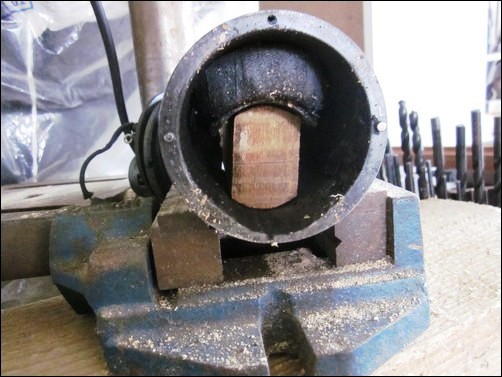 |
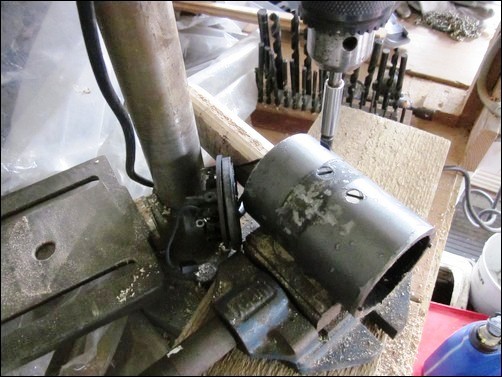 |
| 2a | 2b |
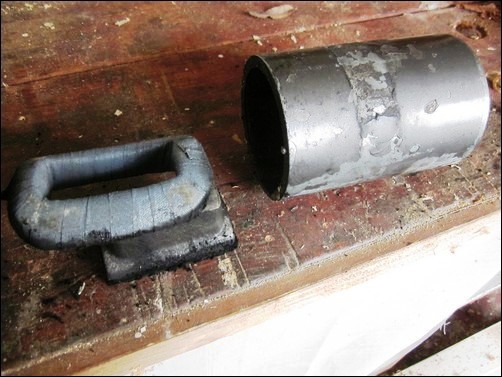 |
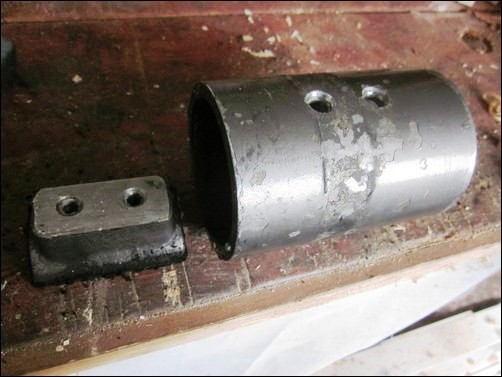 |
| 3a | 3b |
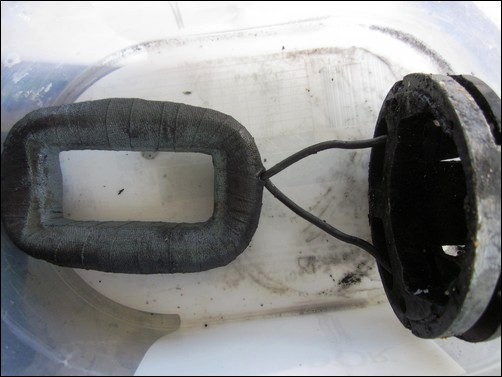 |
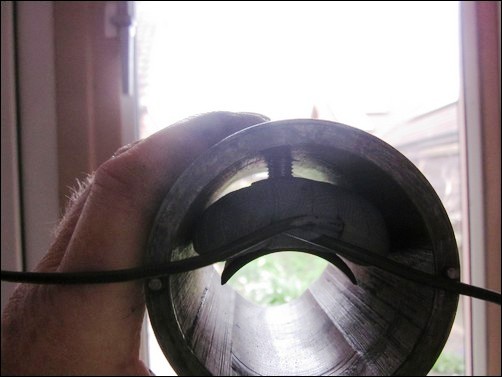 |
| 3c | 4a |
After degreasing and cleaning the
reusable parts assembly commenced.
I started to install the
12v Field Coil. I
slipped the coil over the shoe and offered the pair into the
body of the dynamo but the new screws would not engage with the
tapped holes in the shoe. There
was a noticeable gap between the shoe and dynamo body interface.
See pic 4a.
The cause of the problem
was the new coil was too wide and was in contact with the dynamo
bore. I had a dilemma,
should I proceed and draw up the shoe using longer screws and
deform the coil, but risk damaging the coil by breaking the
internal wire insulation or halt proceedings to consider my
options. I chose the
latter.
The 12v coil
appeared larger than the removed 6v coil.
When measured, the
overall width was 6mm wider but also the internal width was
approximately 3mm wider. So, in theory, there was some room to
reduce the width. However I certainly did not want to damage the
coil through lack of experience at a financial cost of £45 plus
postage together with the hassle and time delay for getting a
replacement. Proceedings
were delayed whilst a query with a couple of photos were sent
via email to Andrew asking if this was “normal” for a new coil
and was it ok for me to proceed.
Andrew replied by return confirming the new coil was
typical and prior to fitting he prepared each coil by crimping
in a vice to reduce the width.
With some soft wood in place to act as
jaw protection against the coil, and the shoe held in place to
prevent over crimping, the assembly was positioned in the vice.
The vice was gradually tightened whilst checking the freedom of
the shoe. Once the coil
gripped the shoe the vice was partially released, the coil
naturally opened slightly. With the shoe removed the vice was
again tightened slightly beyond the position when the shoe was
in place, then relaxed to trial fit the shoe. This was repeated
until the coil slipped snuggly over the shoe without pressure
applied via the vice jaws. See
pics 4b to 4d inc.
The shoe and coil was then offered up in the dynamo bore, the
gap at the joint interface was much reduced and the new screws
engaged with the tapped holes. See
pic 4e. Before
tightening each screw I decided to measure the resistance of the
coil to check if any damage had occurred.
It measured 11ohms,
which is typical for a 12v coil. Phew!
With the two securing screws in place
and gradually tightened until the shoe and dynamo body
interfaces were in contact I then firmly tapped my piece of wood
into the gap between the field coil shoe and dynamo bore.
I then removed each
screw, applied a film of Threadlok Loctite and inserted both
into their respective holes, gradually tightened each in turn as
far as I could with a large screwdriver.
I then positioned the assembly onto the drill vice and
under the drill spindle. Next
I lowered the drill spindle to engage the hexagon drive flat
screwdriver bit onto each screw and rotated the chuck to fully
tighten each screw whilst maintaining sufficient vertical
pressure to ensure the bit did not slip from the screw slot.
As when removing each
screw it is important not to overload the vertical down force
and risk distorting the dynamo body.
With both fasteners
tightened, for good measure, and practiced before Loctite was
available, I centre popped each screw against the dynamo body.
Part 3 to follow
I lived on the Chilterns back in the sixties, Stirling lived
down in Tring. He had a sister Pat. I had the
Vincent twin with quite good lights at the time (Amazing!) I
remember Pat Moss Carlsson used to come up Chesham Vale on
the way to Tring late on Saturday night and a couple of
times I "accidentally" met her where the street lights ended
and raced her up Chesham Vale. I knew that road like the
back of my hand. She had a white Sasb two-stroke car.
I could beat her when the road opened out on the common
after the climb but not on the twisty bits. She would toot
her horn as I pulled in at home. she passed away about 10
years ago. Tim
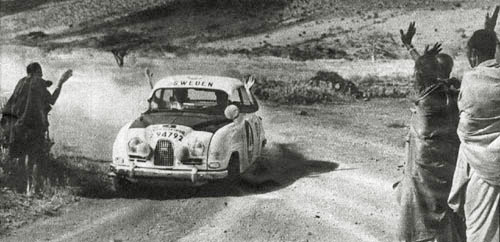
Pat Moss Carlsson drifting her Saab. Looks
like it could somewhere in Africa.
A write up on event from John Goodall:-
Another fantastic run I took part in was with the Velocette
Owners Club Biennial run to Wennings Farm in Leer, Northern
Germany during 2010, known as “The Border Raid”. Leer is
situated just over the border beyond Enschede towards
Munster. This was organised by Mike Ayriss of the East
Midlands Section Velocette OC. The British contingent all
met up on route to Hull north of Nottingham A52/A46 Services
and then rode in convoy. I think there were six of us
including Bob Higgs and the late Tom Tunnicliffe from our
local area. It rained off and on virtually the whole weekend
from Friday to the Monday when we returned home. I was
riding a 1957 Viper 350cc, Bob was on his Special 500cc
Venom with many home made features including leading link
forks and cast alloy primary drive case and Tom on his
Thruxton. We boarded the boat with a large contingent of HD
riders going to a camping weekend in Holland and we saw them
for many miles after disembarking in Rotterdam, usually when
we were overtaking them as we cruised at 70-75MPH most of
the way. We arrived at Heinrich Wennings farm late in the
afternoon in a dry period. It is officially billed as a
camping weekend, but a barn was utilised where campers could
place their sleeping bags. I opted to use a local small
Hotel along with two or three others. I think wisely as it
turned out, less to carry as well?
After breakfast the next day we
all assembled at the farm and met some of the other riders
from Holland, Germany and France. There were two riders on
Moto Guzzi machines from the UK who had been touring, Nigel
Lines was on his honeymoon I think?? Malcolm Smith and his
wife who had also been touring were in a Mazda MR2 sports
scar
all were now present. We then went to visit a “wind
farm” in the Wenning farm grounds which was very interesting
as it provided much of the income covering farm overheads,
which also had with a large “swine” herd and a Trout Fish
farm. We continued on to an unusual water park where divers
in snorkelling gear negotiate an underwater obstacle course
and you could view their progress from underwater cameras.
It did rain occasionally this day, but did not spoil the
enjoyment too much. We had a light lunch there and then rode
back to the farm for a Smoked Trout meal in one of the barns
provided by our host which was delicious. Drinks could be
purchased from a well stocked table.
The Sunday dawned rather wet and
a ride to a German sports car manufacturer making a car
named “Gecko” was organised which was closed when we
arrived, so all we could do was look through the windows. It
was a very futuristic building with a costly looking large
steelwork animal meant to be a Gecko sculpture on the roof.
The running gear of the car was probably Mercedes, but not
sure now? The cars were very nicely styled with two or three
body variations evident, although I have never seen one
since then. The evening meal was again in the Barn with buy
your own drinks available again with very much bonhomie and
conviviality.
The ride home was again accompanied by rain, torrential in
some places, but all six of the Velocettes managed the 70
plus cruising speed again across Germany and Holland to
Rotterdam, we all had full luggage on each bike and Mike
Ayriss the leader had his wife on their Venom as well as a
tank bag , luggage rack and panniers We stopped once to have
a drink, light refreshment and refuel at an unmanned
services. I was particularly pleased with the way the Viper
performed as all the other machines were 500cc with one
Thruxton.
I had many problems with the
engine in this bike when it was first rebuilt prior to this
ride which had a new (but eccentric as I was later to
discover), set of cams provided by a well known supplier who
was not interested in any redress at all?? It was a
particularly difficult thing to discover why the bike would
not perform and I had first tried to use it on The Irish
Rally running the engine in I thought, would cure it during
the event ,wrong it didn’t?? I realised the valve timing was
at fault and advanced it by two teeth on the second day of
the Rally. It helped but not much and it was only cured with
a used set of cams replacing the duff ones after getting
home. So this ride in mostly pouring rain at the time very
onerous and demanding with full concentration needed
continuously, was in hind sight the most satisfying ride I
had on that machine. We met up and again passed many
bedraggled HD riders riding back to the port. I seem to
remember we averaged well over 60 MPH from leaving Germany
to arriving in Rotterdam mostly in pouring sometime
torrential rain. Not many bikes of that period will manage
this today. The only changes from standard on the Viper were
a12volt alternator and one of Bob Higgs electronic Ignition
units which made starting much easier and gave smoother
running.
We had fish and
chips which went down very well at a restaurant Mike knew on
the banked River estuary near the port. You can sit and
watch the boats, some massive ships with containers stacked
amazingly high passing by to dock. Riding back after
reaching Hull Mike noticed he was loosing petrol from his
fuel tank which it turned out had developed a crack and we
stopped at a Truckstop just outside Lincoln for repairs. Bob
“The Builder” Higgs had an epoxy repair kit in his extensive
tool kit and some metal from a beer can plus a suitable
curing time all went back together with no further leak. The
tank bag and luggage reapplied and the journey home was
completed without further incident.
The Border raid
is no longer run today because both Heinrich and his wife
suffered health problems and could not continue their
generous sponsorship and hosting. A fabulous event lost.
John Goodall
Quiz Chat 14:- This one will test you knowledge and research skills. What, where and when? Answers by by email to
edgrew@virginmedia.com
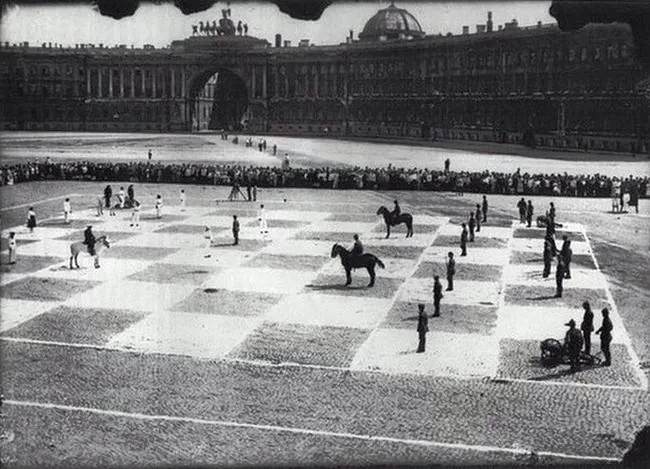
In the pipeline for the next few chats:-
Part 4 of Trevor Shakespeare's AJS saga, more articles from John Goodall something from Mick Leach and hopefully more from anyone else out there. It doesn't have to be a long text, we are not all good story tellers and a picture is worth a thousand words.Easy things you can do:- a photo of and maybe a few words about your first bike, best bike, worst bike, whatever, etc. Don't worry if your spelling or grammar isn't great as I will do my best to sort that. If you have a picture or pictures for an article try to type a caption in your text so that I know where best to put them in the text. Eddy
